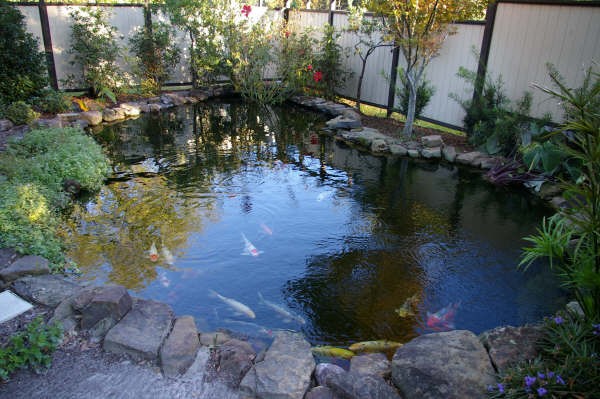An artificial reservoir on a private plot can be a source of not only aesthetic, but also gastronomic pleasure. With some effort to breed fish, you can get a good help in providing yourself and your loved ones with valuable fresh product. And if you approach the case in a big way, then earn. After all, to do everything at home in the country is not so difficult.
Table of contents
Suitable fish species for breeding in the pond
Fish species are selected according to the breeding conditions. The determining factors are air temperature and water composition. Essential is the type of pond - flow or standing. When selecting species, consideration should be given to the joint survival of the breeds and competition for food. The most unpretentious and productive are:
- Carp or carp - thermophilic, but resistant to temperature fluctuations. Diet - plant food and feed. In puberty enters 1-3 years depending on the ambient temperature. Varieties - scaly, mirror and leathery.
- White amur - a large relative of the carp. Reaches the weight of 50 kg and more. Homeland - the Far East. Eats a large amount of plant food, is used to clean overgrown reservoirs.
- Black carp - similar to white, but eats mollusks. Scales of dark color. Well sanitizes ponds from pests of other species.
- White and bighead carp - very similar up to 3 years of age. Then mottled spots appear on the scales. Reach 50 kg. The silver carp feeds only on plants. Motley is more unpretentious.
- Buffalo - looks like a carp, the birthplace of America. According to growing conditions, it is similar to carp, but meat is much more valuable in taste.
- Channel catfish - omnivorous, large, thermophilic. Homeland America. With proper feeding it has a very pleasant taste of meat.
Less productive, but well amenable to breeding in a man-made pond, are:
Trout, pike, tench and sturgeon are also bred in artificial ponds.
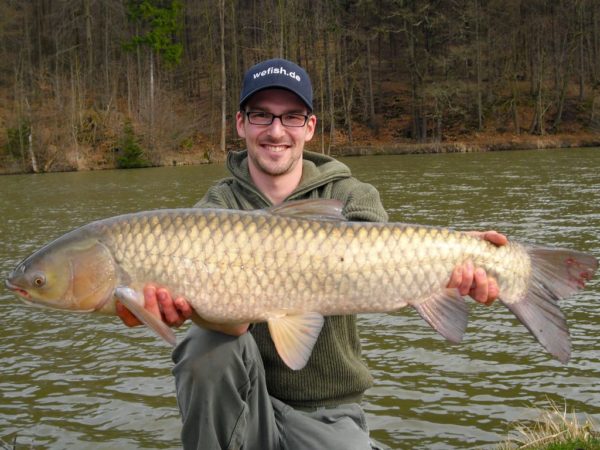
Advantages and disadvantages of home-grown fish
An important advantage of breeding in the backyard conditions is the opportunity to receive for personal consumption or to sell products that are in high demand all year round.
The investment required to start fish farming is not very large. The complexity of the cultivation - from 3 to 5 hours a day.Weather conditions when using an artificial reservoir slightly affect the growth of individuals.
The main investments occur at the initial stage. Need to build a pool or dig a pond.
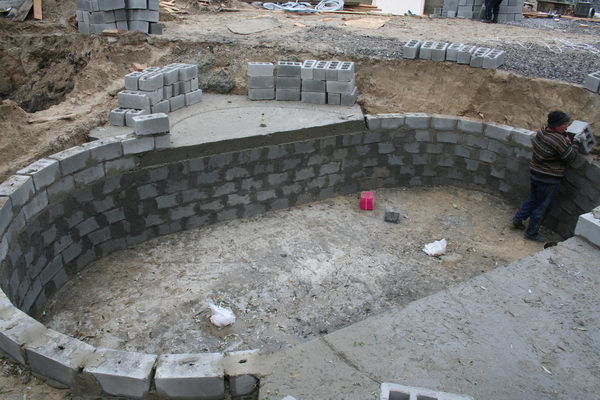
Their type and size are determined by the financial capabilities of the owner and the area of the site. The minimum depth of an artificial reservoir is 1-1.5 m. The volume is calculated from the estimated number of individuals settled in the pond. One fish with a length of 10-15 cm should have at least 50 liters of water, i.e. in one cubic meter the reservoir can coexist peacefully no more than 20 copies.
Recommended water surface area is 25-50 sq.m. Usually for a set of mass fish is 1.5-2 years.
Types of breeding pools
The quality of water in the mini pond, its chemical composition depends on the source of filling the pond. It also determines the temperature, the availability of food and the oxygen supply of the aquatic environment.
What type of filling reservoir exists:
- Stream or river. Water enters the reservoir from natural sources through the inlet channel. The excess is removed by the diversion channel. The content of oxygen and plankton in the pond with this filling is favorable for breeding, because closest to natural conditions.
- Spring Clean water with a high oxygen content is most favorable for breeding fish of different breeds. For the source of food in the area adjacent to the reservoir, daphnia pits are arranged - small, small depressions for reproduction of plankton. They communicate with the main body of water. Daphnia move to the pond and serve as fish food.
- Atmospheric. In the absence of rivers, streams and springs, the source of moisture is rain and melt water. Well heated water is favorable for the development of vegetation and living organisms.
- Closed water supply. The use of ponds without external water sources was made possible by the use of special equipment: pumps, filters, UV sterilizers, etc. When constructing a reservoir, special attention should be paid to bottom waterproofing.
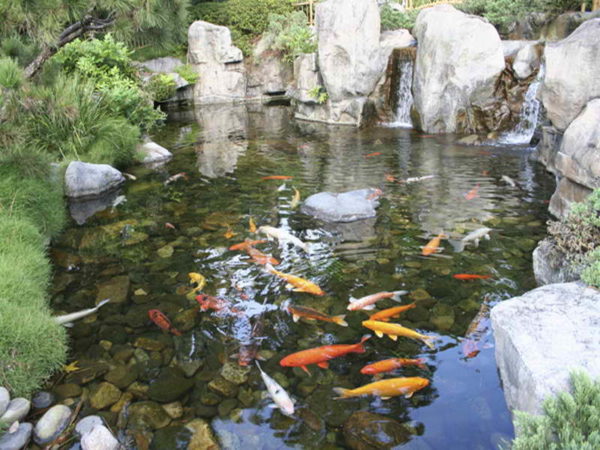
How to make a pond with your own hands
Having decided to arrange a fish pond at the site, it is necessary to determine its location, area and method of construction. If there are no natural sources of filling, the reservoir is built using a closed water supply.
How to choose the site
The place for the pond must meet the conditions:
- be away from noisy places and highways
- to be shaded by trees, but not under them, because falling foliage pollutes water
- not located in the valley, because there is a danger of contamination by draining rainwater,
- have a source of electricity for equipment with water purification filters and oxygen enrichment plants.
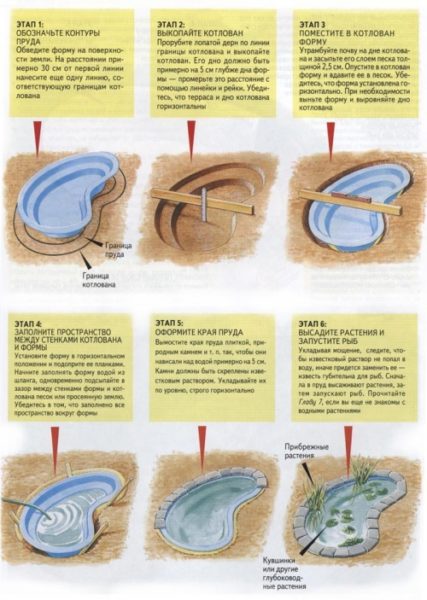
Necessary tools and materials
The most durable is a pond with a concrete bottom. His device requires significant material and labor costs, which will be repaid with interest in the process of long operation.
For the construction of the pond will require:
- rubble
- sand,
- cement,
- grids of reinforcement with a diameter of 3-4 mm and a cell of 30x30 cm,
- planking,
- roofing material or other material for waterproofing the bottom and walls,
- tubes for air inlet and drainage,
- waterproofing additive for plaster bottom and walls.
The technology of creating an artificial reservoir in the country
- Mark up the size of the pond on the ground. To do this, use the pegs and cord. For fish farming, the shape of the pond is irrelevant.
- Dig a pit manually or with an excavator. The optimum depth is 1.5-1.8 m., The angles of inclination of the walls are 20 °.
- Before concreting arrange the preparation of sand and gravel with compaction of the bottom.
- Lay waterproofing of roofing material or film with its conclusion to the surface of the earth.
- The first layer of concrete is poured onto the bottom with a thickness of 10 cm, tamped and reinforced mesh along the entire bottom.
- Make a fill of the second layer of concrete.
- Install the formwork for the walls of the pond. In finished form, they should be 10-12 cm thick.
- Reinforced and poured concrete walls of the reservoir.
- Concrete surfaces covered with plaster with a waterproofing additive or liquid glass. The material for processing walls should be safe for the life of the fish.
- Install the necessary equipment: pumps, filters, oxygen enrichment water.
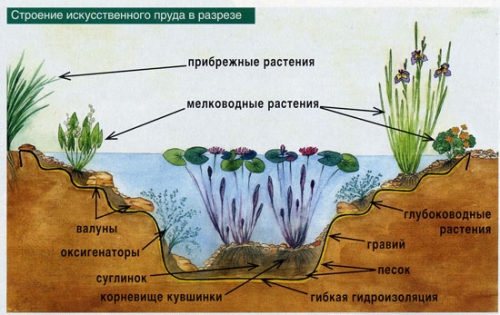
Build a pond with your own hands under the force, even a novice.Fish farming does not take much time if the process of stocking, feeding and catching is adjusted. Even if the goal of breeding fish is not income, this occupation will be beneficial and enjoyable.
